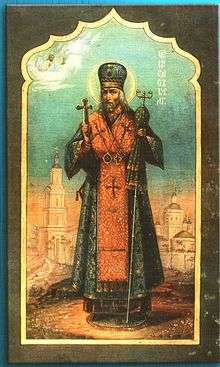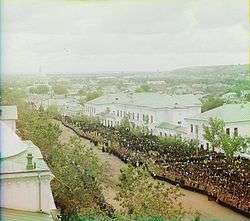Joasaph of Belgorod
Saint Joasaph of Belgorod (Russian: Иоасаф Белгородский; secular name Joachim Andreievich Gorlenko; 8 (19) September 1705 – 10 (21) December 1754) was an 18th-century Russian Orthodox hierarch, bishop of Belgorod from 1748 until his death.
Saint Ioasaph of Belgorod | |
|---|---|
 Saint Ioasaph of Belgorod | |
| Born | 8 (19) September 1705 Priluki, Pryluky Regiment, Cossack Hetmanate, Tsardom of Russia |
| Died | 10 (21) December 1754 Grayvoron, Belgorod Governorate, Russian Empire |
| Venerated in | Eastern Orthodoxy |
| Major shrine | Cathedral of the Transfiguration of Our Lord in Belgorod, Russia |
| Feast | 10 December |
His remains were found to be incorrupt, and after many miracles he was glorified by the Eastern Orthodox Church in 1911. Stolen from his shrine in 1917, the saint's body was thought to be lost but was eventually found in storage in a museum and returned to Belgorod in 1991.
Early life
Born at Priluki, in Russia′s Hetmanate (modern-day Ukraine), Joachim Gorlenko was the son of Colonel Andrei Dmitrievich Gorlenko of the Pryluky Regiment by his marriage to Maria Danylovna, a daughter of Danylo Apostol (1654–1734), a significant military leader and Hetman of the Cossack Hetmanate from 1727 until his death. After attending the Kiev Theological Academy, in 1725 the young Gorlenko was tonsured a monk of the Mezhyhirya Monastery, under the name of Hilarion.[1]
.jpg)
Career and miracles
In 1727 Hilarion (as he then was) took monastic vows and received the name of Ioasaph, and in 1728 he was ordained a deacon. By the end of that academic year he was teaching at the Academy. In 1737 he was appointed archimandrite of the Mhar Monastery near Lubny. In 1744, by command of the Empress Elizabeth, Iosaph was advanced to the rank of archimandrite and translated to become head of the Trinity Lavra of St. Sergius, the most important Russian monastery and the spiritual centre of the Russian Orthodox Church. On 2 June 1748 he was consecrated as bishop of Belgorod and Oboyanska.[1]

After his arrival in Belgorod, Ioasaph was noted for his untiring efforts for his diocese and especially for his work to help those in need, often visiting the poor and the sick.[2]
He died on 10 December 1754, aged only 49, at a village of Graivoron. On 15 December his body was taken from there to Belgorod and was placed in his Holy Trinity Cathedral. Not until 28 February 1755 was the coffin transferred to a crypt in the cathedral which had been made on Ioasaph's orders. Some years later his body was found to be incorrupt. News of this spread, and the sick began to visit the coffin of Ioasaph, many reporting cures. The miraculous power of Ioasaph's relics became known throughout Russia, and every year more people came to Belgorod to seek their help. Ioasaph thus gained the aura of a saint, and portraits of him became popular. In 1883 the Holy Trinity Cathedral became a monastery cathedral, and a series of requests for Ioasaph's glorification began to be made. Finally, in 1910, Tsar Nicholas II asked the Holy Synod to glorify Ioasaph as a saint, which it agreed to do. On 4 September 1911 the glorification was celebrated in the Holy Trinity Cathedral, Belgorud, attended by more than 200,000 people, many of whom had come from all over the Russian Empire and beyond.[2]
Before the First World War, Ioasaph's relics were greatly venerated and were brought out for the curing of the sick, when great crowds came hoping for a miraculous cure. One who attended such an occasion wrote "Now, it is hard to imagine that sight: thousands and thousands of sick, bent, crippled, possessed, and blind people stood and lay on both sides of the road, along which the saint's relics were to be carried."[3] A substantial shrine, made of silver, was created in the Holy Trinity Cathedral.[2]
In the summer of 1914, when news came of the Austro-Hungarian monitor bombardment of the Serbian city of Belgrade beginning on 29 July 1914, one landowner, Prince Obolensky, spoke stirringly to his peasantry of the need for war, and they reacted enthusiastically. He later learned that his hearers had understood him to mean the Belgorod which held the relics of the recently glorified Ioasaph.[4]
Loss and return of the relics
After the October Revolution of 1917, the Bolsheviks removed Saint Ioasaph's remains from his shrine in the cathedral at Belgorod, and for some seventy years their whereabouts remained unknown. In 1927 the Holy Trinity Cathedral itself was demolished. In the late 1980s the remains were discovered in the Museum of the History of Religion and Atheism of the Academy of Sciences of the USSR in Leningrad, and on 16 September 1991 they were solemnly returned to the new Cathedral of the Transfiguration of Our Lord in Belgorod, the occasion being marked by a service in which Patriarch Alexy II took part.[2] The same year, Leningrad returned to its former name of Saint Petersburg.
Ioasaph's name is still revered by the Orthodox faithful, and above all by those from the Ukraine.[5]
The Feast of the Opening of the Relics of St Ioasaph, Bishop of Belgorod, is celebrated on 4/17 September and also on 10/23 December, the date of his death.[6]
Dedications
.jpg)
The Orthodox Church of St Iosaph in Muddy, Illinois, was built in 1913 and dedicated to the newly consecrated St Ioasaph of Belgorod. The spelling "Iosaph" was chosen.[7]
There is a Fellowship of Saint Ioasaph of Belgorod in Shanghai.[8]
In 1912 Ivan Vassilievich Skorodumov (1888–1955) was tonsured a monk and named Ioasaph in honour of the newly glorified St Ioasaph. He later became Archbishop Ioasaph of Buenos Aires, Argentina and Paraguay.[9]
Notes
- St Ioasaph Archived 2001-03-02 at the Wayback Machine at st-jhouse.narod.ru (in Russian), accessed 20 January 2012
- ST. IOSAF THE DIVINE PROTECTOR at angelfire.com, accessed 19 February 2012
- St. Ioasaph of Belgorod at fatheralexander.org, accessed 19 February 2012
- Dimitri Obolensky, Bread of Exile (Harvill Press, 2003), pp. 22–30
- William Furry, Shadows of the Motherland Archived 2012-02-26 at the Wayback Machine dated August 6, 2009, from illinoistimes.com, accessed 19 February 2012
- Complete List of Saints Archived 2012-07-13 at Archive.today at pomog.org, accessed 19 February 2012
- Story of The Church of St. Iosaph in Muddy, Illinois Archived 2008-12-23 at the Wayback Machine at stbasilthegreat.org, accessed 19 February 2012
- Saint John of Shanghai 01 at orthodox.org.ph, accessed 19 February 2012 Archived 21 November 2008 at the Wayback Machine
- Archbishop Ioasaph (Ivan Vassilievich Skorodumov), Archbishop of Buenos Aires, Argentina and Paraguay at rocorstudies.org